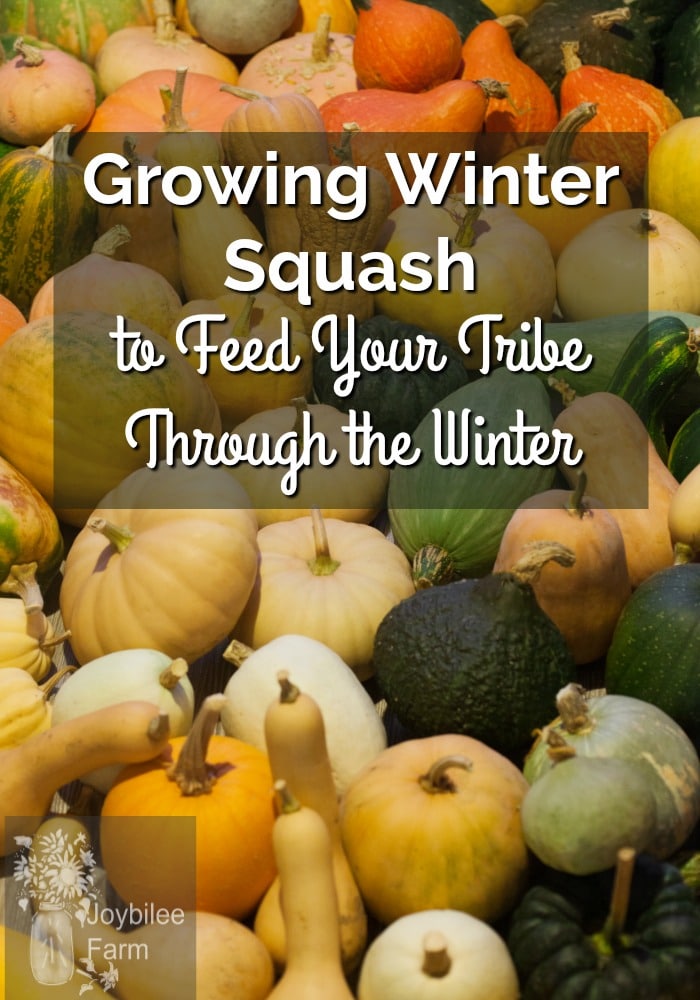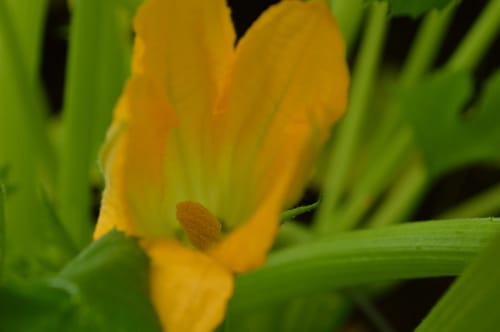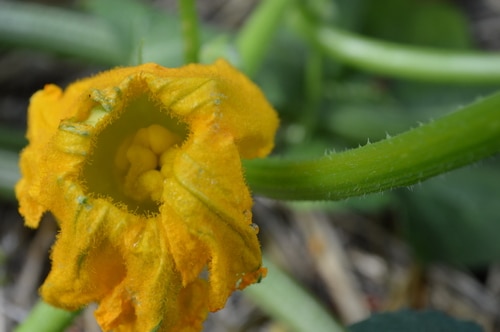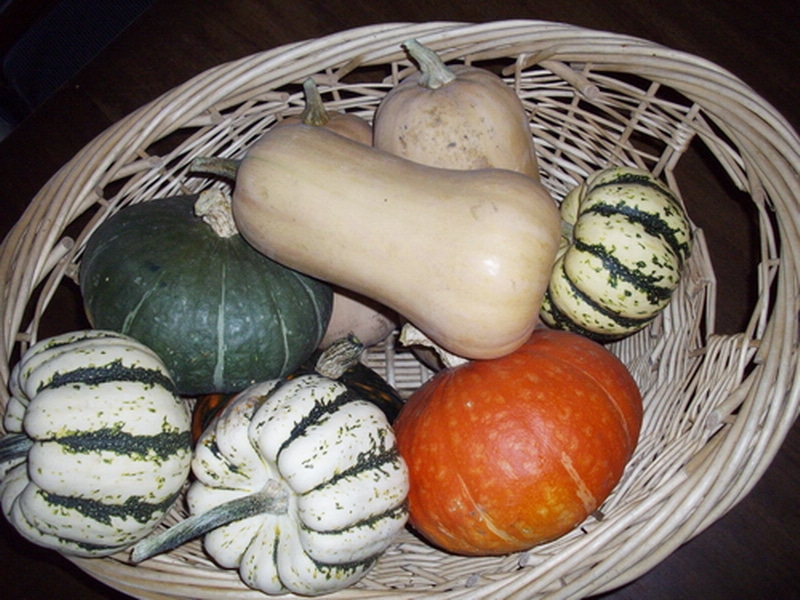The squash plant is easy to grow. With proper pollination, it can feed your tribe all winter, and provide seeds for the next season. Learn how you can do it too.
The winter squash and summer squash plants are commonly known as zucchini, butternut, acorn, delicata, pumpkins, and about a dozen other lesser grown varieties. They are all members of the squash family, whose botanical name is Cucurbita spp. There are 3 basic groups and they won’t cross-pollinate when you plant them together in the garden. A fourth group is less common and doesn’t follow these rules. Does cross-pollination matter? It does if you are trying to save your own seed.
You can plant one type of each family group and still have pure seed, provided your neighbours aren’t growing squash, and you have a long enough growing season to bring them to maturity. Squash seed remains viable for at least 3 years so consider growing out your favourite varieties for seed once every 3 years. For more information on growing pumpkins and squash see this article.

Squash group #1 – Cucurbita pepo
C. Pepo is the family name for all zucchinis, and summer squash. These are bush plants and produce over the full summer if you have a warm climate. You can extend the season by starting the plants indoors in April and planting out in a hotbed after all danger of frost has passed. For Joybilee Farm the danger of frost never passes so I usually plant mine in a greenhouse. C. Pepo varieties also include spaghetti squash, some Halloween pumpkins, and acorn squash.
Identify them: The stems of Cucurbita pepo are deeply ribbed and the outside of the fruit is almost smooth, although it may have fine ridges. The plants have a bushy growth habit.
Squash group #2 – Cucurbita maxima
Giant pumpkins fall in the C. Maxima group, as well as Hubbard, turban squash and buttercup.
Identify them: These plants are identified by their smooth, spongy stems.
Squash group #3 – Cucurbita moschata
My favourite squash is the butternut which falls into the C. Moschata family. It is called butternut pumpkin in Australia and is used interchangeably with dishes that call for pumpkin. It’s my favourite because of its thin, easy to peel skin, and its deep orange, sweet flesh. If you pick butternut squash before the skin is hard it will continue to ripen in storage. As it ripens it will become deeper orange and sweeter.
Identify them: Other C. Moschata squash includes pie pumpkins with deeply ribbed skins, and kabocha, a Japanese squash, with green skin and deep orange flesh. The stems on C. Moschata are prickly and finely ribbed.
Squash group #4 – Cucurbita mixta
The fourth variety of squash is C. Mixta, represented by the cushaw varieties. These will cross-pollinate with both C. maxima and C. Moschata so if you want to save seed you will have to isolate these from all other squash except C. Pepo varieties.

Male Squash Flower

Female Squash Flower
Saving seed from your squash plant
If you want to save your own seed make sure you have two plants of one variety. You’ll need to hand pollinate your plants using a male flower from one plant and a female flower from another. Tape the flowers closed after pollination to prevent cross-pollination by insects. Mark the stem of your hand-pollinated flowers with a piece of twine so that when you harvest your squash, you’ll know which squash has your pure seed.
When to harvest squash plants
It’s best to leave the squash on the vines until they are mature, as most will not ripen after picking. As mentioned above, the one exception to this is Butternut squash. Some varieties will tell you they are ripe by looking at their stems – they will turn dry. With other varieties, it can be hard to tell. No matter what, you should harvest before a frost settles in the garden. Letting winter squash sit in the garden with frost on them greatly reduces their storage time once they are picked.
If frost is coming and you still have an unripe squash plant or two, pick the ones that are ripe and cover the others with heavy straw or mulch. You can also gather the plants together (without breaking the stems) and place a heavy blanket over them. Remove any covering the next morning so the plants get sunshine and airflow.
When the squash is ripe, harvest it by cutting off the stem a few inches from the top of the fruit and then allow it to harden off in storage for at least a month, before cutting it open and saving the seed. To prepare the seed for storage until next year, rinse the seed after scooping it from the plant and allow the seed to dry in the open. Store once the seed is completely dry. One squash will give you ample seed for family use.
Preparing squash for winter storage
To prepare squash for winter storage, you want to purchase specimens that are fully ripe, with stem intact and free of cuts to the skin or blemishes. If you are growing your own, eat the squash that has cracks in the skin or stem removed first. The scar where the stem falls off tends to mold first in storage. If the squash is not yet mature but the outside of the skin has begun to colour, the squash may harden off in storage. Place these at the front of your storage and plan to use them first.
Before placing them in storage, wash the outside of the squash in soapy water, rinse and wipe with a mild bleach solution or rubbing alcohol to remove bacteria. Allow the disinfectant to dry on the outside of the squash. Store in a cool, dry place on shelves and be sure to check the squash frequently. Often they will begin to spoil from the inside out around the end of February or the beginning of March, so plan to use them up by then. I’ve had some last till June, but by then we’re pretty tired of squash and the garden is giving us early kale, lettuce, and some radishes.
If a squash begins to spoil you can cut off the spoilage and use the intact flesh, provided the inside of the squash has no mold growing in the seed cavity. Chickens love squash, so consider sharing the bounty through the winter, if you have ample for your needs.
Torpedo zucchini (those overgrown fruits you found in the garden) will harden off as well, with the skin getting thicker and the flesh thinning out and leaving a hollow seed cavity with mature seed. You can use these in winter.
I like to save some torpedoes to feed the chickens in January. Just cut them in half to expose the seeds, and leave them in the hen house. The hens will clean them up leaving only the shell.

How to cook squash
Squash is used as both a vegetable and a fruit (in pie or custard). Summer squash can be eaten raw or lightly sauteed. Winter squash can be baked, grilled and stir-fried. Baking it in a slow oven concentrates the sugars. I like to put the whole squash in the wood stove oven in a baking dish with a small amount of water. After the squash softens remove the top, scoop out the seeds, and remove the flesh. We like to mash it with butter and serve it as a vegetable. It’s a really simple meal on a cold day.
For small squash like delicata or sweet dumplings, you can remove the top, hollow out the seed cavity and then fill with chopped apples, raisins, almonds and a bit of brown sugar and butter. Place the top back on and bake it whole. It’s delicious!
Other viable fillings include mixtures of cooked meat, onions, coconut milk, and curry spices. Use your imagination.
Squash bisque is a creamy soup made with pureed squash or pumpkin, onion, garlic, and spices. Serve with a sprinkling of toasted nuts or savoury cream. After all, you can do a lot more with squash and pumpkin than just pie!
Your turn:
What’s your favourite squash to grow and have you been successful in saving your own seeds? Leave a comment.



thanks for including me in this round up next to what look like some amimzaang dishes! I definitely will be checking them all out… I mean, butternut squash flatbread? oh, you are calling my name!happy weekend 🙂